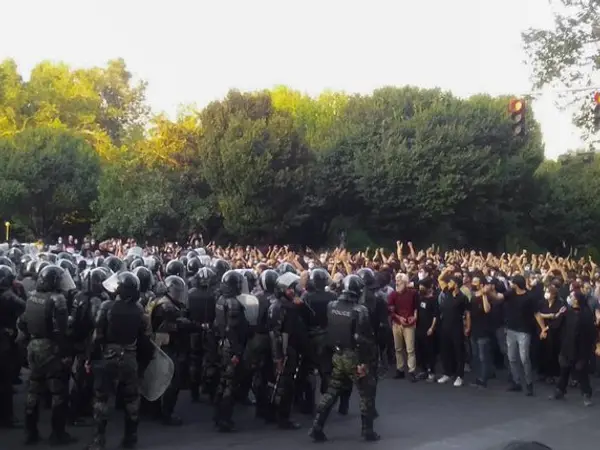A leaked audio file seems to prove that Iran's protest movement has gained so much ground that authorities can no longer deny its gravity or hide their despondency.
In a speech to the Revolutionary Guards’ Basiji militia members Saturday, Supreme Leader Ali Khamenei, who had so far not acknowledged the serious challenge the protest movement poses to his rule, confirmed his fears by trying to boost the morale of his loyalists and exhorted them “never to lose hope under any circumstances.”
Khamenei also told the chief of police recently, “Don’t let your morale drop,” according to the leaked audio file of a recent insiders’ meeting focusing on the protests.
Regime propaganda is increasingly proving inept and easy to counter and disprove by the popular opposition whose only platform for expression is social media. The said audio file seems to confirm that protesters have gained the upper hand in what the speaker, deputy commander of the paramilitary Basij Qasem Qoreyshi, refers to as “media war”.
The state had banked, for instance, on World Cup football victories to cast a normal, happy image of the society, but last week when the state media tried to make the win against Wales into a big celebration, many chose to follow the social media campaigns to disown the national team and stayed home even in areas where past celebrations were always the biggest. Photos of riot police cheering in their full gear and parading on their motorbikes in the streets served as proof of the point that the team represented “them”, not “us”, many said.
Authorities have waged a campaign of disinformation for years and a host of fake accounts to counter opponents’ social media activities and campaigns, to sow discord among them, and to spy on them. This tactic succeeded somehow at first, but it seems that they’ve been found out and some fake accounts are now being more carefully considered. Many are quickly losing followers they had managed to lure with content that sometimes looked the most aggressive against the regime.
Facts also seem to have become more and more difficult to hide and distort as individuals and families are taking strength from the growth of the movement. The public eventually finds out every time when other citizens are killed, injured, or arrested, and do not believe when the authorities deny responsibility.
Nearly 450 protesters have been killed but the state not only has not taken responsibility for even one case, but has also cast the blame on others, even protesters themselves. Such incidents have only resulted in greater anger among citizens and more power to the protest movement.
The outbreak of unrest could have been possibly prevented if the death of the 22-year-old Mahsa Amini which sparked the protests could have been hidden from the public. But her family refused to remain silent.
As a result, few believe the official account when Atefeh Na’ami, 37, was found a few days ago in the balcony of her apartment under a blanket with a gas pipe near her mouth.
Authorities say she committed suicide but her family who calls the regime and its officials “occupiers” insist she “gave her life for freedom”. According to her brother, security forces buried her quietly with only a few female members of the family present.
The grievances of the Iranian public are not limited to lack of freedom or social issues, as the slogans chanted by protesters may suggest. What probably causes the greatest concern to the authorities is that protests have not yet become as extensive in impoverished areas where the 2019 deadly protests were the most intense.
In the leaked audio file one of the participants in the meeting quotes the secretary of the supreme national security council, Ali Shamkhani, as saying that 70 percent of Iranians believe their living conditions are fast deteriorating.
